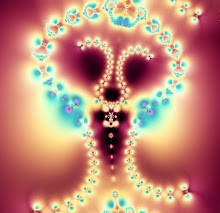Cornflower. Fractal created by Lynn. Used Fractal Explorer.
Centaurea cyanus, commonly known as cornflower or bachelor's button, is an annual flowering plant in the family Asteraceae native to Europe. In the past, it often grew as a weed in cornfields (in the broad sense of "corn", referring to grains, such as wheat, barley, rye, or oats), hence its name. It is now endangered in its native habitat by agricultural intensification, particularly by over-use of herbicides. However, Centaurea cyanus is now also naturalised in many other parts of the world, including North America and parts of Australia through introduction as an ornamental plant in gardens and as a seed contaminant in crop seeds.
Centaurea cyanus is an annual plant growing to 40–90 cm tall, with grey-green branched stems. The leaves are lanceolate and 1–4 cm long. The flowers are most commonly an intense blue colour and arranged in flowerheads (capitula) of 1.5–3 cm diameter, with a ring of a few large, spreading ray florets surrounding a central cluster of disc florets. The blue pigment is protocyanin, which in roses is red. Fruits are approx. 3.5 mm long with 2–3 mm long pappus bristles. It flowers all summer.
Centaurea cyanus is native to temperate Europe, but is widely naturalized outside its native range. It has been present in Britain and Ireland as an archaeophyte (ancient introduction) since the Iron Age.[ In the United Kingdom, it has declined from 264 sites to just 3 sites in the last 50 years. In reaction to this, the conservation charity Plantlife named it as one of 101 species it would actively work to bring 'back from the brink'.
In the County Clare (VC H9) in Ireland, Centaurea cyanus is recorded in arable fields as very rare and almost extinct, while in the North-East of Ireland, it was abundant before the 1930s.
Centaurea cyanus is considered a noxious weed in arable crops, especially cereals and rapeseed. In winter wheat, one plant per m2 can cause a yield loss of up to 30 kg / ha. Centaurea cyanus produces around 800 seed per plant, which are either shed shortly before the harvest of cereals, or they are threshed together with the cereal grains, contributing to the further spread of the species by the harvesting machinery and contaminated seed. The occurrence of Centaurea cyanus strongly decreased during the last decades due to improved seed cleaning, more intensive nitrogen fertilization and herbicide use. However, Centaurea cyanus has become more common in cropland due to an increase in crop rotations dominated by winter cereals and rapeseed and the use of more selective herbicides with a low effectiveness against Centaurea cyanus. In addition, the emergence of resistance against the herbicide class of sulfonylureas has been reported recently. Due to its strong roots, Centaurea cyanus is difficult to control mechanically in spring.
text below All About Cornflower (americanmeadows.com)
Centaurea cyanus is a member of the Asteracea or Compositae family, which is a large and widespread group of plants that includes sunflowers, daisies, and asters. The genus is Centaurea, which includes both annual and perennial varieties. The following description focuses on C. cyanus, which is the annual flower, grown easily from seed and popular as a bedding plant or cut flower for home gardeners and florists.
Centaurea cyanus readily grow from seed and will thrive when sown indoors in pots 4 weeks before a frost-free date, then transplanted, or outdoors directly in the garden.
Centaurea cyanus is often used as a boutonniere in weddings, and because of their popularity, have been bred to produce plants for a wider range of blossom colors, including white, pink, red-purple, deep burgundy (sometimes called black) and the crisp blue which is the only true natural color.
Centaurea cyanus is called ‘Bluet’ in England and ‘Bluebonnet’ in Scotland, in North America they are sometimes called Ragged Robin, or Ragged Sailor because of the shaggy petals. They are one of the few true blue flowers that are also edible, imparting a sweet cucumber like taste. In the garden, they are visually stunning planted with brightly colored Nasturtiums, Marigold and California Poppies. In a vase, they blend well with Snapdragons, Sweet William and Love-in-a-Mist (or Nigella)
The Centaurea cyanus shape and brilliant blue color is similar to chicories, and has many associations throughout the world; it is the national flower of Estonia, representing the Estonian political party, and a symbol for social liberalism with the Swedish National Party. The blue cornflower also plays a role in German history, thanks to Queen Luis of Prussia who purportedly hid her children in a field of cornflowers.
Centaurea cyanus blue was adopted for the uniforms of the Prussian army. In France, the cornflower is a common symbol for veterans of World War to wear, as a reminder of the 1918 Armistice, similar to the remembrance of poppies worn in the UK and Canada.










0 Comments:
Post a Comment